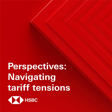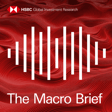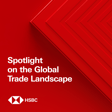Become a Creator today!Start creating today - Share your story with the world!
Start for free
00:00:00
00:00:01

The Macro Brief – Payback time?
James Pomeroy, Global Economist, examines whether the frontloading of global trade in the first half of the year could unravel as new tariffs kick in.
Disclaimer: https://www.research.hsbc.com/R/101/zDWvnwS
Stay connected and access free to view reports and videos from HSBC Global Investment Research, just search for #HSBCResearch on LinkedIn or click here: https://www.gbm.hsbc.com/insights/global-research.
Transcript
Introduction and Subscription Invitation
00:00:01
Speaker
Welcome to HSBC Global Viewpoint, the podcast series that brings together business leaders and industry experts to explore the latest global insights, trends, and opportunities.
00:00:13
Speaker
Make sure you're subscribed to stay up to date with new episodes. Thanks for listening, and now onto today's show.
Podcast Production and Disclaimers
00:00:24
Speaker
This podcast was recorded for publication on the 7th of August, 2025 by HSBC Global Investment Research. All the disclosures and disclaimers associated with it must be viewed on the link attached your media player.
00:00:34
Speaker
And don't forget to like and subscribe to The Macro Brief wherever you get your podcasts.
Introduction to The Macro Brief and US Tariffs
00:00:44
Speaker
Hello, I'm P.S. Butler and welcome to The Macro Brief from HSBC Global Investment Research, the podcast that looks at the issues driving financial markets across the globe. And once again, the headlines are being driven by US tariffs, with a slew of new rates coming into force for dozens of countries.
00:01:01
Speaker
But despite this uncertainty, global trade had a stellar start to the year as companies sought to get ahead of the tariff increases. So what can we expect now that these new tariff rates have kicked in? And is there going to be payback for this front loading over the coming quarters?
Front-loading in Trade
00:01:15
Speaker
To discuss this, I'm joined by James Pomeroy, global economist. James, great to have you back. Pleasure to be back. So in a way, you've made it easy for me to sort of kick off this podcast because the title of your latest report was How Much Will Trade Fall When Front Loading Stops?
00:01:31
Speaker
So I guess that's the key question. But perhaps for our listeners, give us a sense of when this front loading started. Did it start just after Liberation Day or was it already beginning to happen before that?
00:01:42
Speaker
So there's so much front loading that's happened into the U.S. economy throughout this year and it's almost staggered by product. So at the very beginning of the year, had a huge boom in trade flows going to US of precious metals, particularly gold. and People were desperately trying to get their gold into the US ahead of any would-be tariffs. So even before any tariffs were announced, you had front-loading of gold.
00:02:00
Speaker
And then subsequently, you saw sort of tariffs picking up for different products in different countries. And um kind of companies were trying to get ahead of each of those little ones. You've almost had this very jumpy sort of period through the whole of the first half this year, where every month it's different products getting front-loaded, different products getting their payback.
00:02:17
Speaker
So it really is messy. and But over the course of the first half of the year, US imports are up quite a lot. Give us a sense of scale. So if you look at so the US import data, talking about 5%, 6% up over the first half of the year.
00:02:29
Speaker
If you look at sort of Chinese exports to the US, they're down a long way, but Chinese exports in general up pretty well. ah Global trade volumes, which is probably a fairer way of looking at things, are up nearly 5% in the first half of the year. So you're talking actually, for all the pessimism out there, global trade has had a remarkably good um first half of the year. It's just been so staggered in terms of the products and the countries who have seen the impact um over the over those months.
00:02:52
Speaker
And so talking about products, interestingly, in your report, you highlight that the effect is very skewed in terms of the different products that have been impacted. Give us a sense of that.
00:03:03
Speaker
Yeah, I think this is the most interesting thing. I think a lot of the time at the moment in markets, people are spending a lot of time just looking at the headline numbers that pop up on their Bloomberg screens or wherever else and not actually getting into the weeds of it. And the weeds of it are more important today than ever before.
00:03:15
Speaker
So that's what we've tried to do in this report is look not just in terms of the countries and who's seeing that sort of benefit or or or downside risk, I guess, in terms of trade flows, but looking at the product mix and digging down into HS codes, these sort of um definitions you get for different product groups. We looked at very detailed product groups and slightly less detailed.
00:03:33
Speaker
But what you can see very clearly is a lot of the front loading has happened with industrial goods. So it's metals, fertilizers, and there's precious metals, of course, in there as well.
00:03:43
Speaker
But it's broadly things that companies in the supply chain are bringing in a part of their production process, getting ahead of all of these tariffs. Whereas when you look on the consumer good side of things, if you look at things like clothing, electronics, the things you would have thought, OK, here's these big tariffs coming in. Let's get this product in and beat the tariffs.
00:03:59
Speaker
People just haven't front loaded those at all. If if anything, a lot of those products have seen imports well below where you'd expect them to be at this time of the year. Now that suggests that actually a lot of companies are saying, you know what, we'll wait, we'll hope these tariffs come down or they disappear or some sort of agreement comes through and then we'll bring the stuff in.
00:04:16
Speaker
But it poses a big risk for the second half of the year because that stuff's got to come into the US economy if people are going to keep consuming. And it means that that impact of tariffs on both inflation and consumer sentiment could be much greater than maybe a lot of people are thinking.
Impact of Tariffs on Trade and US Imports
00:04:29
Speaker
Right, so what can we now expect ah given that quite a lot of tariff rates have been set? I know trade agreements take a long time to bed down in terms of the detail, um but what's the outlook for the second half?
00:04:43
Speaker
It's probably not great in terms of global trade. So if you think about those consumer goods that are still going to come in, there's a good chance they come in at a lower rate because the tariff that's now on those products, you know, it varies by country and by product, but you're talking 10, 15, 20, 25, 30%
00:04:58
Speaker
that naturally will mean that US producers and companies and consumers want less of this stuff. So you should see some downside risk even in the stuff that hasn't been front loaded.
00:05:09
Speaker
But on the industrial metal side and on the areas of the economy where you've seen huge amounts of front loading, there's got to be some substantial payback. And our best guess is that US imports over the course of the next year will drop by about 8.5%. Now, that'll be much greater in some categories, like those ones that have been really front-loaded, chemicals, fertilisers, etc.
00:05:28
Speaker
But also really clearly from some economies who have seen their exports to the US absolutely boom in the first half of this year. There's a lot of smaller emerging market economies who have seen this, but you've also seen the likes of Ireland with pharmaceutical exports, Switzerland, pharmaceuticals and gold, Australia with gold. and These sorts of exports have been so far above where you'd expect them to be normally, the payback for these economies could be exports to the US dropping by 50% over the course of the next year, just to get to something on par. These are big numbers, but it's just a sign of quite how much downside risk there could be a queuing up in terms of ah that payback
00:06:03
Speaker
to come from the front loading we've seen already.
US vs. Global Inflation Trends
00:06:05
Speaker
Right, let's go global now. ah You've also just published a latest edition of your Global Childbook. It's kind of like a freeze frame on what's going on in the economy. um And firstly on inflation, the outlook there doesn't look so bad.
00:06:18
Speaker
No, it's a very different story between the US and the rest of the world. In the US, you've got this sort of building inflationary pressure from these tariffs. And you can see that both from what we know about where tariffs going to get to and the likely trade flows, but also what's happening with some of the um sort of broader...
00:06:34
Speaker
data that we're getting. So you can see this in the survey data, businesses saying, you know what, our input costs have gone up. You can see it in components of the inflation data in the US that price is already rising. You don't have any of those effects elsewhere in the world.
00:06:45
Speaker
Elsewhere in the world, you've got energy prices broadly down. You've got this sort of oversupply of goods in the global economy that aren't going into the US, helping to put some downward pressure on goods prices.
00:06:57
Speaker
And across Europe, Latin America, Asia, broadly, you're seeing very, very good inflation data and inflation that's heading back towards central banks' targets and allowing central banks to cut rates. And that sort of cocktail is a powerful one. Because it's meaning that you're getting upside surprises on growth in Europe, in China, in other parts of Asia in the first half of this year, which we never would have expected in a world of all of these tariff increases.
00:07:20
Speaker
So here's a tricky question. Is that why the equity markets are taking this taft disruption in their stride? I mean, ahqu equity markets are sort of reaching new highs. i mean, I guess maybe inflation tamed, positive growth outlook, expectation of further rate cuts. What's not to like?
00:07:36
Speaker
I think there's a few things at play here. One is actually, yes, growth is holding up a little bit better. And secondly, on the face of it, US economy is holding up a little bit better than many people would have expected. You have this sort of heavily distorted by trade.
00:07:48
Speaker
Good news story in terms of GDP growth in the second quarter. The underlying data nowhere near as good and we've seen some wobbles in the labor market. But it's not just about that US story. The rest of the world is looking a little bit better. Growth is holding up in those ah other economies and we're raising, we've just raised our growth forecasts in many other parts of the world.
00:08:04
Speaker
But it's also a sectoral story. In the US, the underlying sort of broad economy is not necessarily doing amazingly well, but it's certainly not collapsing, but it's not enough to be pushing stock prices to record highs. What you're seeing is sectors of the economy that are doing unbelievably well, like AI, tech companies, these guys, who are a big part of this driver, ah driving equity markets higher. These are the companies who are making a lot of money in the sectors of the economy that are performing really, really well.
00:08:28
Speaker
And it adds to this sort of broad story of understanding the economy at the moment is really, really hard because not only have you got messy economic data, you've also got some sectors that are having the greatest time imaginable and other sectors having a really rough time of it.
Equity Markets vs. Economic Performance
00:08:41
Speaker
And that that sort of gap between the winners and losers is getting bigger. But in the US stock market's case, the winners are very large companies who are making even more money and prices are going up. I guess what you're saying in simple terms is the stock market is not the economy.
00:08:56
Speaker
And also, I'm minded to recall the saying from the economist Paul Samuelson that the stock market has predicted nine of the last five recessions. Exactly. I think it's one of these things as an economist. When the stock market goes up, everyone sort of just always says to me, stock market has gone up fine.
00:09:13
Speaker
But when the stock market goes down 20%, everyone tells me a recession is inevitable. And it's in times like this where it's really important to remember that disconnect can happen when you inevitably at some point in the future get a correction in the stock market. It doesn't mean you're necessarily going to recession in the same way that the same thing is true now.
00:09:27
Speaker
Just because the stock market is up doesn't mean the economy is booming. And that sort of disentanglement is probably more relevant today than it has been at any point in history.
Economic Data and Fed Rate Cuts
00:09:34
Speaker
At some point, though, things reconnect. And maybe to finish on, let's come back to the U.S. where the real data is finally catching up with the survey data. By that, I'm referring, of course, to the labor market data that we saw at the end of last week, where we saw some significant revisions downwards.
00:09:49
Speaker
is that the Is that the real data really starting to tell us a story? I think it is. And the US economy, we have expected for some time to show a few wobbles because of the uncertainty created by tariffs. We published a few things in the last couple of months, looking at some of the more detailed ways of looking at this. And and with the one thing I like to spend a lot of time looking at is the qualitative data. So rather than spending our time just looking at that latest print that's popping up on your Bloomberg screen, look at what businesses are telling us in the comments, in the details, what businesses are saying in the earnings releases and so forth.
00:10:18
Speaker
And that mood music has been much, much weaker than the hard data. So if you look at, say, the ISM manufacturing, the last three months, the the comments that are in that report are terrible. how Absolutely terrible. And yet the survey is weak, but it's not that bad.
00:10:31
Speaker
And I think almost what we're now seeing is the reality that's in that qualitative data hitting the quantitative data. And you've had these big downward revisions in terms of the payrolls numbers. That's not the biggest surprise in the world. You look at where those job gains had been. They've been in the government sector, which can be heavily revised with seasonal adjustment.
00:10:49
Speaker
It's been in health care, similar potential story there. And the breadth of those employment gains has been terrible for months. And it's now sort of that headline figures reflecting some of those deeper underlying data points. And it reinforces this point I made earlier that now is a really, really important time to spend your time getting into the weeds of the data, looking at the detail you can get out there and looking at a broad range of data sources.
00:11:09
Speaker
It will help you understand the economy much better. And what that sort of breadth of data tells you at the moment is US economy is weakening, it's softening, it's certainly not going into a recession right now, but there are signs of things cooling down a little bit.
00:11:21
Speaker
And that's why why we think the Fed will start rates cutting cycle or resume its rate cutting cycle in September. Just a final question. and we we talked about it a little bit earlier, but the AI boom. I mean, isn't there vast sums being invested? Does that not show up in the real economic data?
00:11:37
Speaker
It certainly will. And you saw this a little bit in the first half in the US, where investment growth was relatively decent, considering all of the broad sort of uncertainties that are out there. So a lot of businesses are saying, you know what, we're going to hold back on our investment decisions, and therefore you'd expect investment growth to be really weak.
00:11:51
Speaker
But actually, the hard data saying things are a little bit better, i.e. there's other parts the economy that are doing well. So AI is an area where you see this, but it's very concentrated. Actually, the amounts being spent are not going to move the dial on the overall US economy. these jobs so These investments are not the most labour intensive. You're not going to completely turn around the jobs market.
00:12:10
Speaker
What you're talking about with AI and the economic impact is partly that construction. It does help things at the margin, but the AI impact is seen later. It's the impact of all of that technology seeping into the workplace, getting productivity gains, getting that lift to to output that comes from that, that's when you see the positive impacts. And and that's a multiple year story rather than necessarily thinking about Q2 or Q3 2025.
Upcoming US Economic Indicators
00:12:33
Speaker
I'm not sure I'll see it as a positive when AI replaces us as podcasters, but just to finish on, any big data releases that you're watching out for in the in the coming weeks?
00:12:42
Speaker
Really the only things that matter now are US inflation and US labour market data. Everything else is sort of slightly less important, let's say, in the grand scheme of things. I would flag the US s trade data as being really important if you want to understand what's really happening under the surface. We've just had the June data. We'll get the July data, which are sort of meaningless in many ways because it's just ahead of the August um tariff increase. So I'll be looking out for those numbers in the next couple of months.
00:13:05
Speaker
US labor market data, of course, very important because the Fed has made it very clear. The most important thing is the unemployment rate in the US. And the US s inflation data, we get that next week, will be super important because it's another sign of what is that tariff impact really on prices.
00:13:18
Speaker
If we get another sign that it's continuing to seep through into these certain pockets, that's going to make some people quite nervous. James, on that note, thank you very much. Wonderful. Thank very much.
App Features and Availability
00:13:29
Speaker
reminder that if you're an HSBC Global Investment Research client, then don't forget to download our mobile app. The app features all our latest research, videos and podcasts, and you can find it on Apple's App Store and Google Play.
00:13:42
Speaker
And if you'd like to get in touch with us, you can do so by emailing us at askresearch at hsbc.com. We're taking a break for a couple of weeks to recharge our batteries, so the next edition of the Macrobrief will be the end of August.
The Macrobrief and Asian Markets Insights
00:13:55
Speaker
But don't worry, you can still get your podcast fix as our sister program, Under the Banyan Tree, will be returning next week. So please, join Fred Newman and Harold van der Linde as they delve into what's going on in Asian markets.
00:14:08
Speaker
But for now, it's goodbye from us. Thanks for listening, and we'll be back soon.
00:14:35
Speaker
Thank you for joining us at HSBC Global Viewpoint. We hope you enjoyed the discussion. Make sure you're subscribed to stay up to date with new episodes.
















